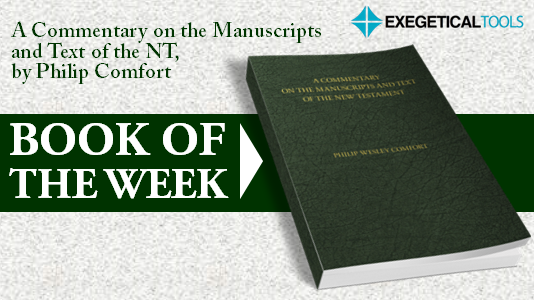Textual criticism is a specialized practice with lots of symbols, methodologies, and esoteric knowledge. Moreover, in order to be extremely skilled at textual criticism, one must have access to manuscripts to study or at least see them physically, which some scholars have the opportunity to do. But the best most of us can do is use the critical apparatus of our Greek New Testaments to see the variants and try to discern the original reading.
Enter Philip Comfort’s new Commentary on the Manuscripts and Text of the New Testament. This little reference book will assist pastors, students, and even scholars in their pursuit for the original text of the New Testament, and also for the significance of variants throughout the early manuscripts of the New Testament. Comfort has written extensively on New Testament manuscripts, his New Testament Text and Translation Commentary being a superb volume.
Personally, I think the name of the book does not properly reflect its contents, or the value of its contents. This book is valuable in some respects, but should not be expected to do certain things.
1. Concise Guide to the Early Manuscripts
Comfort’s first chapter is a concise introduction to the types of early manuscripts and their general classifications, as well as brief coverage of the typical canons of textual criticism. The second chapter is an annotated list of every New Testament manuscript, including papyri, uncials, miniscules, ancient versions, and the church fathers. This chapter provides much value. When evaluating variants in a critical apparatus, one can quickly flip to Comfort’s description of that manuscript. He lists the principal edition of the manuscript and then discusses its dating, issues of correctors, and other pertinent information.
2. Commentary on Significant Variants
After the long third chapter describing each of the manuscripts, nearly the rest of the book consists of brief discussions of all the significant variants in the early New Testament manuscripts. Of course “significant” is subjective, so these are significant to Comfort, but nothing is wrong with that.
One should beware, however, that these discussions are more like brief comments and are not of the same kind as those in Metzger’s renowned Textual Commentary on the Greek New Testament. Metzger is concerned to defend the proposed reading that the UBS committee determined is most likely original. While Comfort also seeks the original reading, his commentary on the variants are less concerned with this. He does in many cases explain which manuscripts contain which reading and suggests which reading is original, but there is little argumentation in many cases. Usually, the early manuscripts win out, especially if they are in the majority.
A large percentage of this section is filled with comments on which manuscripts write out Nomina Sacra. While such information is useful, it probably could have been compiled in its own section to make this book much smaller. In short, Comfort’s discussion of variants is complementary to Metzger’s, but the latter’s is still more useful for assessing the original reading of variants.
3. Discussion of Nomina Sacra.
The most stimulating aspect of Comfort’s book is his attention to Nomina Sacra, or “sacred names.” In a 25-page appendix, he discusses all of the Nomina Sacra used in the early manuscripts. These are divine names that are abbreviated with an overbar to denote the abbreviation. Κύριος was among the earliest, followed by Ἱησοῦς, Χριστός, and θεός. Other titles that are not completely consistent are πνεῦμα, πατήρ, υἱός, υἱὸς τοῦ ἀνθρώπου, υἱὸς Δαυίδ, and even σταυρός and σταυρόω (419-443).
Comfort gives a summary explanation of the significance of each name in its ancient Jewish context. But perhaps the most useful idea from Comfort is that, since abbreviations were common in literary papyri from the same time period, some of these abbreviations (such as κυριός, Ἱησοῦς, Χριστός, and θεός) may have been original from the hands of Paul, Luke, etc. While this is impossible to prove, it is a provocative idea.
Should You Own It?
The ultimate worth of this book lies first in its discussion of the Nomina Sacra and secondly in its character as a concise handbook on all the New Testament manuscripts and some significant variants. If you come across a variant and forget the dating of Sinaiticus or of P46, you can quickly turn to Comfort’s volume for a one page summary of these important manuscripts. Other less important manuscripts receive less attention, but enough to give the user some acquaintance with the manuscripts under scrutiny. For this use, I commend Comfort’s work as worthy of a place on your shelf next to your NA28 or UBS5, but not without your copy of Metzger on the other side to make a beautiful Greek sandwich.
Preview or buy it here.



